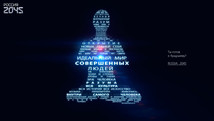/ Фото конкурс
/ experts
- Ph.D. in Biology, Inventor of the "Bioartificial liver" device
 Professor Vyacheslav Y.
Professor Vyacheslav Y.
RYABININ - Russian futurologist writer, journalist
 Maxim
Maxim
Kalashnikov"This is something that nobody in the world could pass up. Creation of super- and posthuman, I believe, is a gaining of new strength while saving from degeneration and extinction, . This could potentially make Russia the world leader…’
- Ph.D. in Physical and Mathematical Sciences, Senior Researcher of the Heat-Resistant Thermoplastics Laboratory at ISPM (Russian Academy of Sciences), creator of nanosensor neurologic ‘Electronic nose’ system
 Mikhail Y.
Mikhail Y.
YABLOKOV‘When creating an artificial human, we need to add an emotional trend to the predominant robotics one. It’s an all-inclusive idea, and it’s in the air...’
- Ph.D. in Medicine, Head of the Cells and Tissues Growth Laboratory of Theoretical and Experimental Biophysics (Russian Academy of Sciences)
 Professor Boris K.
Professor Boris K.
GAVRILYUK“For skin on a cyborg, you simply need to create a nutrition system. And basically . . . we are not really complex in design! There are only a few systems: the circulatory system carries oxygen and nutrients; the excretory system extirpates the waste. The rest is end-effectors. To begin we can create a very simple living organism—then, later, more complex systems. . . .”
- Doctor of philosophy, professor
 Sergei V.
Sergei V.
KrichevskiyOne temporary solution, in my opinion, is to create a “cosmic person”, and start doing so on Earth, within the “future person” project, as part of the “Russia 2045” Initiative.
- Ph.D. in Chemistry, Head of the Chemical Enzymology Department at the Moscow State University, corresponding member of the Russian Academy of Sciences, Director of the Institute of Biochemical Physics (Russian Academy of Sciences)
 Professor Sergey V.
Professor Sergey V.
VARFOLOMEEV‘An electronic version of the brain is needed. The physical brain, in my opinion, can not be a subject of study, since it is very subtle. But an electronic analog having all the receptor equipment and the same story, incentives, motivation - it might be very interesting...’
- Ph.D. in Technical Sciences
 Professor Aleksandr A.
Professor Aleksandr A.
BOLONKIN‘An artificial mechanical body will have great power and withstand extreme environmental conditions: high temperature, pressure, radiation, space...’
- Head of the Space Technology and Telecommunications Cluster at the Skolkovo
 Sergey
Sergey
Jukov"I am absolutely convinced that the movement “2045’ happened exactly at the right time and the right place as I believe in the great future for Russia, in her success after temporary difficulties".
- Ph.D. in Biology, Head of the Lipid Metabolism Laboratory at the Russian Institute of Gerontological Research and Development
 Elena V.
Elena V.
TERIOSHINA‘There is nothing to be afraid of. The project of creating a carrier of an immortal brain is of extreme importance. Nature definitely creates talented, brilliant, genius people – but they are mortal. Mankind creates books and imparts knowledge to descendants. But imagine a genius working eternally!’
- Ph.D. philosopher and psychologist, editor-in-chief of Historical Psychology and Sociology magazine, and a professor at Moscow State University
 Akop Pogosovich
Akop Pogosovich
Nazaretyan“The intelligence of modern man is an artificial intelligence . . .”









 LinkedIn
LinkedIn
 LiveJournal
LiveJournal
 Google
Google
 Twitter
Twitter
 Facebook
Facebook
 Я.ру
Я.ру
 ВКонтакте
ВКонтакте
 Mail.ru
Mail.ru